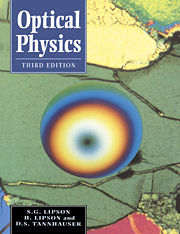Book contents
- Frontmatter
- Contents
- Preface to the third edition
- Preface to the second edition
- Preface to the first edition
- 1 History of ideas
- 2 Waves
- 3 Geometrical optics
- 4 Fourier theory
- 5 Electromagnetic waves
- 6 Polarization and anisotropic media
- 7 Diffraction
- 8 Fraunhofer diffraction and interference
- 9 Interferometry
- 10 Optical waveguides and modulated media
- 11 Coherence
- 12 Image formation
- 13 The classical theory of dispersion
- 14 Quantum optics and lasers
- 15 Problems
- Appendix 1 Bessel functions in wave optics
- Appendix 2 Lecture demonstrations in Fourier optics
- Bibliography
- Index
10 - Optical waveguides and modulated media
- Frontmatter
- Contents
- Preface to the third edition
- Preface to the second edition
- Preface to the first edition
- 1 History of ideas
- 2 Waves
- 3 Geometrical optics
- 4 Fourier theory
- 5 Electromagnetic waves
- 6 Polarization and anisotropic media
- 7 Diffraction
- 8 Fraunhofer diffraction and interference
- 9 Interferometry
- 10 Optical waveguides and modulated media
- 11 Coherence
- 12 Image formation
- 13 The classical theory of dispersion
- 14 Quantum optics and lasers
- 15 Problems
- Appendix 1 Bessel functions in wave optics
- Appendix 2 Lecture demonstrations in Fourier optics
- Bibliography
- Index
Summary
Electromagnetic waves in restricted systems
This chapter will deal with two examples of electromagnetic wave propagation in systems where the scalar-wave approximation is inadequate, essentially because of the small dimensions of the constituent parts. The first is the optical waveguide, already familiar in everyday life as the optical fibre, which has caused a revolution in the communications industry. The second example is the dielectric multilayer system which, in its simplest form (the quarter-wave anti-reflexion coating) has been with us for more than a century, and can today be used to make optical filters of any degree of complexity that are common elements in the laboratory.
Optical waveguides
Transmission of light along a rod of transparent material by means of repeated total internal reflexion at its walls must have been observed countless times before it was put to practical use. In this section we shall describe the geometrical and physical optical approaches to this phenomenon, and derive some of the basic results for planar and cylindrical guides, the latter of which is a model for the optical fibre. Optical fibres have many uses, two of which will be described briefly at the end of the section; the first is for transmitting images, either faithfully or in coded form, without the use of lenses; the second is for optical communication.
Geometrical theory of wave guiding
The principle of the optical fibre can be illustrated by a two-dimensional model (corresponding really to a wide strip rather than a fibre) shown in Fig. 10.1.
- Type
- Chapter
- Information
- Optical Physics , pp. 263 - 289Publisher: Cambridge University PressPrint publication year: 1995
- 1
- Cited by



